You can protect your vegetables naturally by planting seven flowering heroes that act as garden bodyguards. Marigolds deter nematodes and pests, while nasturtiums serve as edible trap crops. Calendula attracts aphids away from leafy greens, and lavender repels harmful insects while drawing pollinators. Sweet alyssum controls aphid populations, cosmos attracts beneficial predators, and chamomile acts as a natural fungicide. These beautiful companions create a thriving ecosystem that’ll transform your garden’s defense strategy.
Marigolds: Natural Nematode Fighters and Pest Deterrents
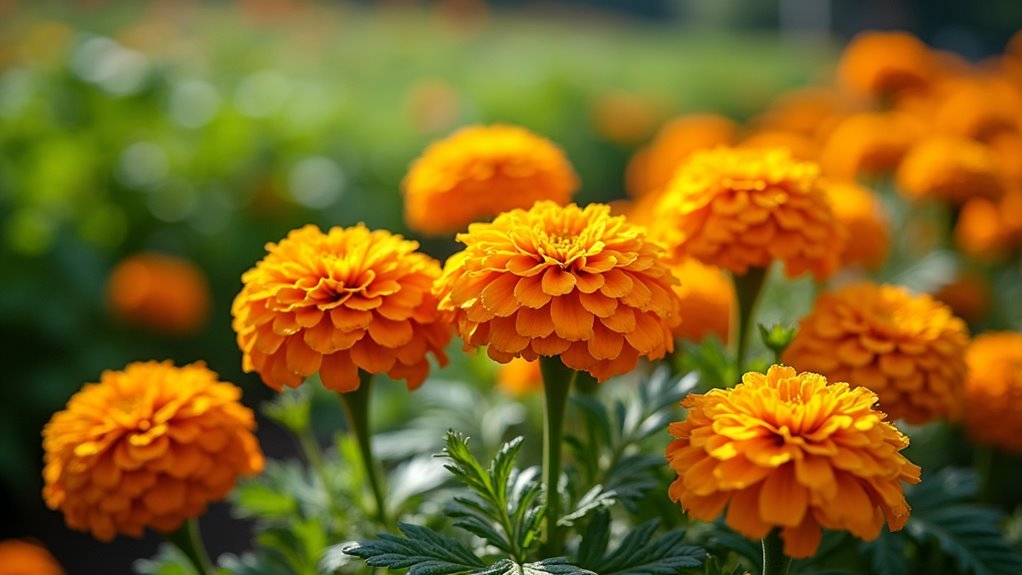
Champions of the garden world, marigolds (Tagetes patula) pack incredible pest-fighting power into their cheerful blooms. These vibrant flowers excel as pest deterrents, releasing pyrethrum that acts as a natural insecticide against aphids, whiteflies, and mosquitoes.
When you plant marigolds in your vegetable garden, they’ll repel nematodes that damage plant roots, making them perfect companion planting partners for tomatoes, peppers, and cucumbers.
Beyond pest control, marigolds attract beneficial insects like ladybugs and hoverflies that enhance your garden’s natural defense systems. They also attract pollinators while potentially improving vegetable flavors.
You’ll find these hardy flowers thrive in full sun across diverse soil types and USDA zones 2 to 11, making them effortlessly adaptable to virtually any garden space.
Nasturtiums: Edible Trap Crops That Lure Pests Away
You’ll love nasturtiums for their clever dual purpose—they act as sacrificial plants that draw aphids, squash bugs, and whiteflies away from your precious vegetables while providing you with peppery, edible flowers and leaves.
These vibrant orange and yellow blooms don’t just protect your garden through pest attraction; they also enhance your kitchen with their spicy flavor that’s perfect for salads and garnishes.
Pest Attraction Strategy
While most gardeners focus on repelling pests, nasturtiums take the opposite approach by acting as irresistible magnets that draw harmful insects away from your prized vegetables.
This companion planting strategy transforms these edible flowers into sacrificial heroes that attract aphids, squash bugs, and whiteflies to themselves instead.
Here’s how nasturtiums execute this pest attraction strategy:
- Create natural barriers around your vegetable garden perimeter
- Concentrate pests in designated areas for easier removal and management
- Attract beneficial insects that prey on garden pests, enhancing biodiversity
- Protect valuable crops by redirecting pest attention to less critical plants
Rather than repel unwanted visitors, you’re strategically controlling where they congregate.
This approach simplifies pest management while maintaining ecological balance in your garden ecosystem.
Culinary Garden Benefits
Beyond their pest-trapping abilities, nasturtiums double as culinary powerhouses that transform your garden into both a protective barrier and a gourmet food source. These edible flowers offer exceptional culinary uses while functioning as an effective trap crop in vegetable gardens. You’ll harvest peppery leaves and vibrant blooms that enhance salads and baked goods, adding dietary diversity to your meals.
| Plant Part | Culinary Application |
|---|---|
| Leaves | Fresh salads, pesto |
| Flowers | Garnishes, vinegars |
| Buds | Pickled capers substitute |
| Seeds | Ground spice alternative |
| Stems | Cooking herb infusions |
While nasturtiums repel pests with their strong scent, they simultaneously attract beneficial insects that support garden health. You’re creating a sustainable ecosystem where protection and nutrition coexist, eliminating chemical interventions while enriching your kitchen pantry.
Calendula: Aphid Magnets That Protect Your Leafy Greens
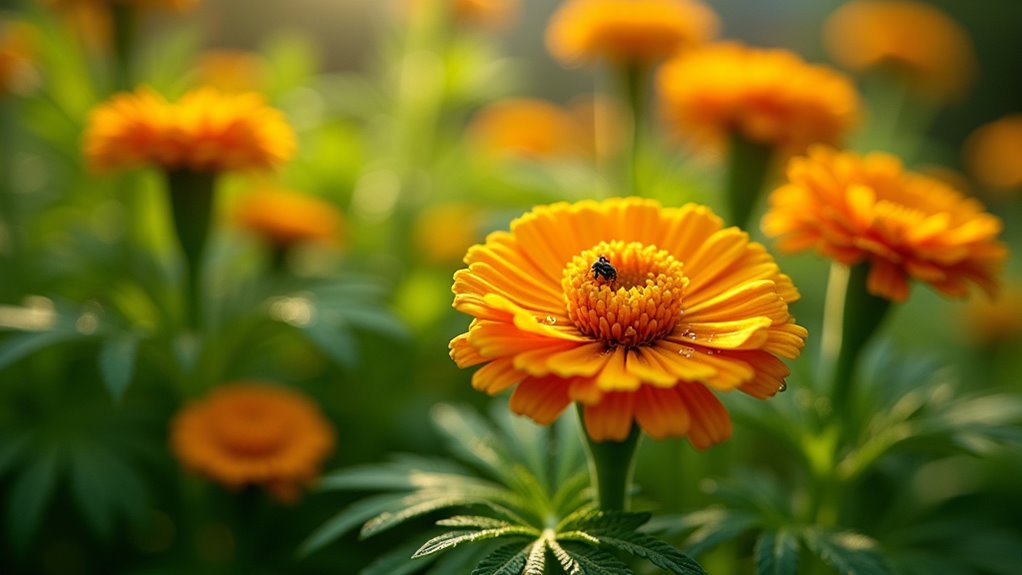
Although calendula might look like a simple decorative flower, it’s actually a strategic garden ally that draws aphids away from your precious lettuce and spinach. This pot marigold serves as an effective trap crop for pest management, deliberately attracting aphids to protect your leafy greens.
Here’s why you’ll want calendula in your garden:
- Easy establishment – Plant seeds directly when soil’s workable for instant pest protection
- Dual-purpose benefits – Enjoy medicinal properties for skin treatments and soothing teas
- Pollinator support – Vibrant blooms feed beneficial insects while enhancing garden beauty
- Adaptable growth – Thrives in full sun to partial shade across growing zones 2-11
You’ll appreciate how this versatile flower tackles multiple garden needs simultaneously.
Lavender: Aromatic Pest Repellent and Pollinator Magnet
When you plant lavender strategically throughout your vegetable gardens, you’re deploying a powerful dual-action defense system that repels harmful pests while simultaneously attracting beneficial pollinators. This aromatic pest repellent effectively drives away mosquitoes, flies, and moths through its potent fragrance, creating a natural pest deterrent around your crops.
Meanwhile, lavender attracts beneficial insects like bees and butterflies, boosting pollination rates and vegetable yields.
Lavender’s sweet fragrance acts as a beacon for pollinators, naturally increasing cross-pollination and maximizing your garden’s productive potential.
You’ll find lavender thrives in zones 5-9 with full sun and well-drained, slightly alkaline soil. Its robust nature makes it an ideal companion plant that requires minimal maintenance.
The essential oils don’t just repel garden pests—they’re believed to enhance nearby vegetables’ flavors. By incorporating lavender, you’re establishing a healthier gardening environment that naturally protects and enhances your harvest.
Sweet Alyssum: Tiny Flowers That Control Aphid Populations
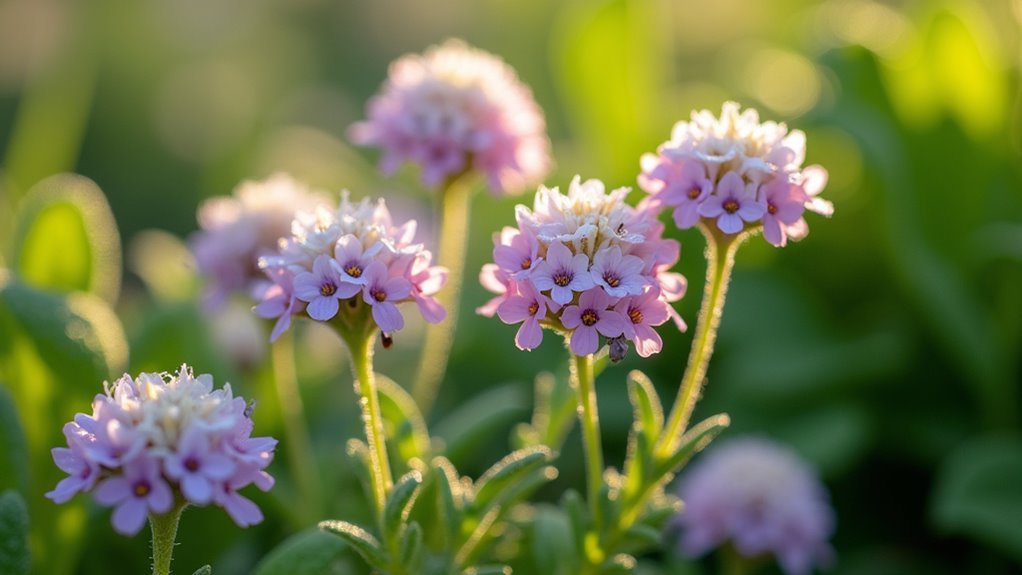
Sweet alyssum transforms your garden into a natural aphid-fighting fortress through its remarkable ability to attract hoverflies and other beneficial insects.
This hardy annual flower produces dense mats of tiny, fragrant blooms that serve as powerful magnets for aphid predators, delivering effective pest control throughout your vegetable gardens.
Here’s why sweet alyssum deserves a spot in your garden:
- Attracts beneficial insects like hoverflies that naturally eliminate aphid populations
- Suppresses weed growth with dense foliage that protects nearby vegetables
- Thrives in zones 2-11, making it adaptable to various growing conditions
- Enhances garden aesthetics while promoting healthier crops
You’ll notice considerably reduced aphid damage when you plant sweet alyssum near vulnerable vegetables, creating a beautiful and functional garden ecosystem.
Cosmos: Beneficial Insect Attractors That Ward Off Harmful Bugs
While cosmos may look delicate with their feathery foliage and papery petals, these powerhouse flowers create an impressive defense system that protects your entire garden from destructive pests.
You’ll attract beneficial insects like bees and butterflies that boost pollination in your vegetable crops while simultaneously repelling harmful aphids and flea beetles. This dual-action approach provides natural pest control without chemicals.
Cosmos thrive in USDA zones 2-11, requiring only full sun and well-drained soil. They’re incredibly adaptable and low-maintenance.
Beyond immediate protection, these flowers enhance soil health by fostering beneficial microbes and fungi. You’re not just adding vibrant color to your garden—you’re supporting biodiversity that creates a healthier, more productive growing environment for all your plants.
Chamomile: Natural Fungicide and Beneficial Insect Haven
Two powerful abilities make chamomile an essential addition to your vegetable gardens: it acts as a natural fungicide while creating a welcoming habitat for beneficial insects.
Chamomile’s small, daisy-like flowers don’t just add visual appeal—they’re working overtime to protect your crops. This versatile herb attracts hoverflies and predatory wasps that naturally control pest populations while inhibiting harmful fungi growth.
Here’s why chamomile deserves a spot in your garden:
- Fungal protection – Its natural fungicide properties keep plants healthier
- Beneficial insect magnet – Attracts helpful predators that eliminate pests
- Pollinator support – Provides essential habitat for pollinators
- Dual-purpose harvest – Perfect for calming herbal teas
Thriving in zones 3-9 with full sun to part shade, chamomile offers protection and beauty simultaneously.
Frequently Asked Questions
What Flower Keeps Bugs Away From a Vegetable Garden?
You’ll find marigolds are your best bet for keeping bugs away from vegetables. They’ll repel nematodes and deter garden pests effectively. Plant them near tomatoes and cucumbers for natural protection.
What Flowers Should Not Be Planted Near Vegetables?
You shouldn’t plant marigolds that attract pests, sunflowers that overshadow tomatoes, nasturtiums that draw aphids, aromatic lavender near fragrance-sensitive vegetables, or flowering dill near carrots due to cross-pollination risks.
What Are the Best Pollinators for a Vegetable Garden?
You’ll want honeybees, bumblebees, and mason bees as your top vegetable garden pollinators. They’re incredibly effective at transferring pollen between flowers, with honeybees boosting yields up to 90% for cucumbers, squash, and tomatoes.
What Is the Best Flower to Plant With Vegetables?
You’ll find marigolds are your best choice for companion planting with vegetables. They’ll repel harmful nematodes and squash bugs while attracting beneficial insects like bees and ladybugs to naturally protect your crops.
In Summary
You’ve now discovered seven powerful flower allies that’ll transform your vegetable garden into a thriving ecosystem. Plant these colorful defenders strategically throughout your beds, and you’ll create natural barriers against pests while attracting beneficial insects. Don’t underestimate these floral bodyguards – they’ll work tirelessly to protect your crops while adding beauty to your garden. Start incorporating these flower heroes today, and you’ll enjoy healthier vegetables with fewer chemical interventions.

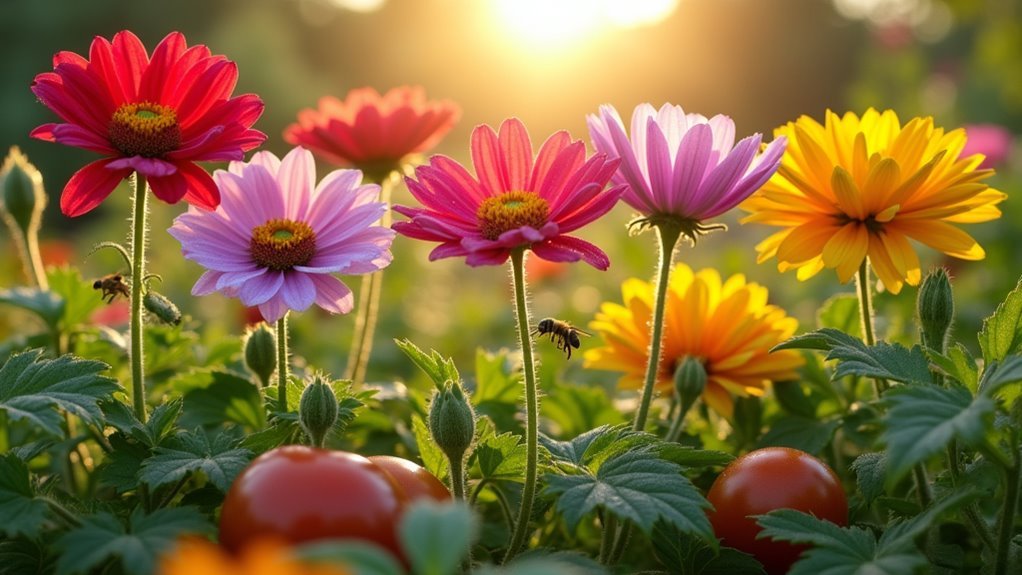
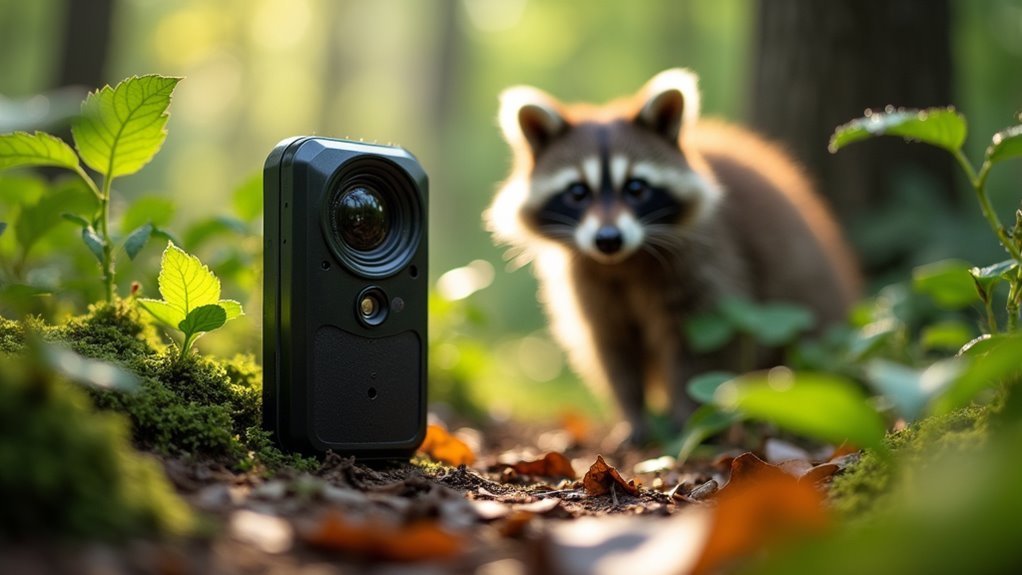

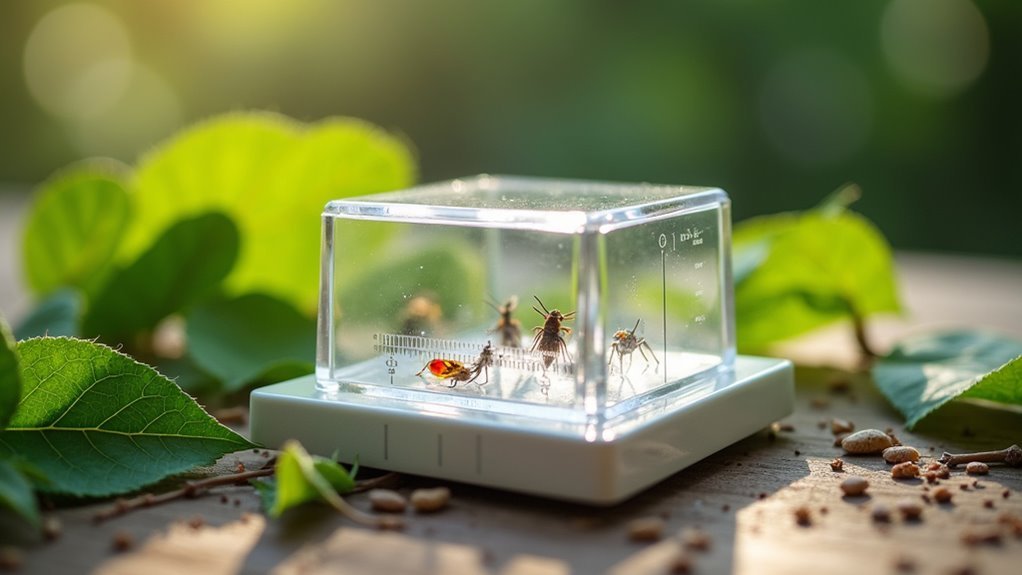
Leave a Reply